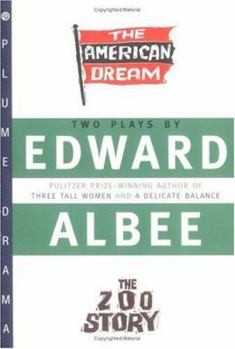The American Dream and Zoo Story
Select Format
Select Condition 
Book Overview
The American Dream: The story of one of America's most dysfunctional families, it is a ferocious, uproarious attack on the substitution of artifical values for the real values- a startling tale of... This description may be from another edition of this product.
Format:Paperback
Language:English
ISBN:0452278899
ISBN13:9780452278899
Release Date:October 1997
Publisher:Plume Books
Length:127 Pages
Weight:0.26 lbs.
Dimensions:0.3" x 5.3" x 8.1"
Age Range:18 years and up
Grade Range:Grade 12 and higher
Customer Reviews
5 ratings
not into plays neither am i
Published by Thriftbooks.com User , 16 years ago
well at least i thought i wasnt. but these two plays are very easy to read and i think theyd also be brilliant to see if only i got the chance. edward albee, pretty much the only playwright i like so far. but he makes me give the area a chance. these two are a great way to get into him and into plays in general.
A theatre MASTER piece
Published by Thriftbooks.com User , 17 years ago
These plays are modern classics. Albee has an interesting view of our modern word (especially the american way of life) and expresses it really good in his theatre plays. Zoo story specially is a 'must do it' play for all the actors
Earliest and the Best
Published by Thriftbooks.com User , 17 years ago
These are the two of the three plays ("Virginia Woolf") that will go down in theater history as Albee's contribution to the stage. The others may not make it. Both of these plays capture Albee at his rebellious best, just in from Westchester County where he had been living the country club life with his adopted parents, and now living in Greenwich Village. "The American Dream" captures the world of his parents, while "Zoo Story" takes up Albee's new life on the streets of New York (paid for out of his grandmother's trust fund). These plays have a vernacular zip and zing his later plays lack. They make for wonderful theater. Much of this early promise was realized in "Virginia Woolf" but then Albee, like the man with three arms, seems to have lost his voice.
Albee's Earliest
Published by Thriftbooks.com User , 19 years ago
An unqualified genius with language, Edward Albee has a fair claim to being the USA's most important living playwright, though most would give the nod to Arthur Miller. *The Zoo Story* and *The American Dream* are among Albee's first plays, and both dabble in the absurdism that defines his work. The plays are very different from each other: *The Zoo Story* is a more serious play that builds slowly toward the inevitable, while *The American Dream* is more of a nonsense-farce, with echoes of Ionesco and Becket. But the logic of *The Zoo Story* and the comic brevity of *The American Dream* make these plays much easier to get a handle on than his later *Who's Afraid of Virginia Woolf* and *A Delicate Balance*. In fact, both plays have a spiffy economy that Albee's work seemed to lose until his recent masterpiece, *Three Tall Women*. Anyone interested in American theater should study Albee, and these plays are a good introduction. Also (unlike most of Albee's plays) these plays could be performed by student or beginning actors.
Mystical Animals in America
Published by Thriftbooks.com User , 21 years ago
Zoo Story There is something unique about the works of Edward Albee, a kind of mood, or wry-but-not-entirely-dry attitude, one recognizes but can't quite put his finger on. This "story" of a suburbanite with two daughters minding his own business on a park bench who is accosted by a poorer but somehow wiser man who has been at the zoo was Edward Albee's first play to be seen by the public. Dating from 1958, the one-act play, which like much of Albee's work seems to deftly mix absurdist elements with an intimate rendering of the American bourgoisie--and a sort of silent, if perhaps ironical, nod to mystical Christianity--he reminds me of a dramaturgic Saint Francis of Assisi--was first seen in Berlin. As in Who's Afraid of Virgina Wolf? and The Goat, the object of desire is off stage, at least until the end, at which point "its" "retrieval" reveals a generalized dissatisfaction which the playwright allows to be dispersed as satisfaction after all, in conformity with the peculiarities of human desire and the conventions of literary endings. This two-man play seems to work largely because the older, more well-to-do man, Peter-a kind of icon of smug suburbanite self-satisfaction, who wants to be entertained, as it were, from the outside--is drawn in--across the white picket fence, or here, the green slatted Central Park bench--to the life of the slightly younger Jerry--a sort of stand--in it would seem for the playwrite, and his dramatic task to involve us all in a participatory experience this side--or perhaps a little more--of religion.The American DreamAlthough I have read/seen only four of Albee's works (Who's Afraid of Virgina Wolf, Zoo Story, and The Goat), this seems to me the work of his that owes most to-or is closest to- the theater of the absurd-particularly to Samuel Beckett. And yet, as the title suggests, the work is far more American-down home, you might say-and so is the humor. The main characters are "Mommy," "Daddy" and "Grandma"-and Grandma is a scream. Her brilliant, if irascible, wit contains some brilliant, if not exactly unbiased, observations on the treatment of, expectations from, and inner reality of, the elderly. She comes off as the most intelligent person in the play, and the one we identify with the most-even if her metaphysical capacities for hiding objects, forgetting who her strumpet daughter is, and desiring with spiritual ardor the flesh of the young who may or may not be her own are not necessarily everyone's instantiation of satisfaction's successful pursuit.





